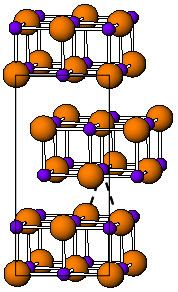Formula TlI | Molar mass 331.29 g/mol | |
 | ||
Related compounds Appearance yellow crystals; red crystals above 170 °C | ||
Thallium(I) iodide (TlI) is a chemical compound of formula TlI. It is unusual in being one of the few water-insoluble metal iodides, along with AgI, SnI2, SnI4, PbI2 and HgI2.
Contents
Chemistry
TlI can be formed in aqueous solution by metathesis of any soluble thallium salt with iodide ion. It is also formed as a by-product in thallium-promoted iodination of phenols with thallium(I) acetate.
Attempts to oxidise TlI to thallium(III) iodide fail, since oxidation produces the thallium(I) triiodide, Tl+I3−.
Physical properties
The room temperature form of TlI is yellow and has an orthorhombic structure which can be considered to be a distorted NaCl structure. The distorted structure is believed to be caused by favourable thallium-thallium interactions, the closest Tl-Tl distance is 383pm. At 175 °C the yellow form transforms to a red CsCl form. This phase transition is accompanied by about two orders of magnitude jump in electrical conductivity. The CsI structure can be stabilized down to room temperature by doping TlI with other iodides such as RbI, CsI, KI, AgI, TlBr and TlCl. Thus, presence of impurities might be responsible for coexistence of the cubic and orthorombic TlI phases at ambient conditions. Under high pressure, 160kbar, TlI becomes a metallic conductor.
Applications
Safety
Thallium(I) iodide is, like all thallium compounds, highly toxic. Conditions/substances to avoid are: heat.
